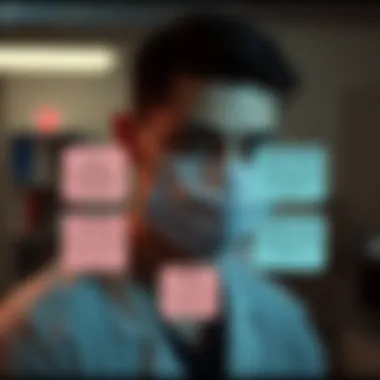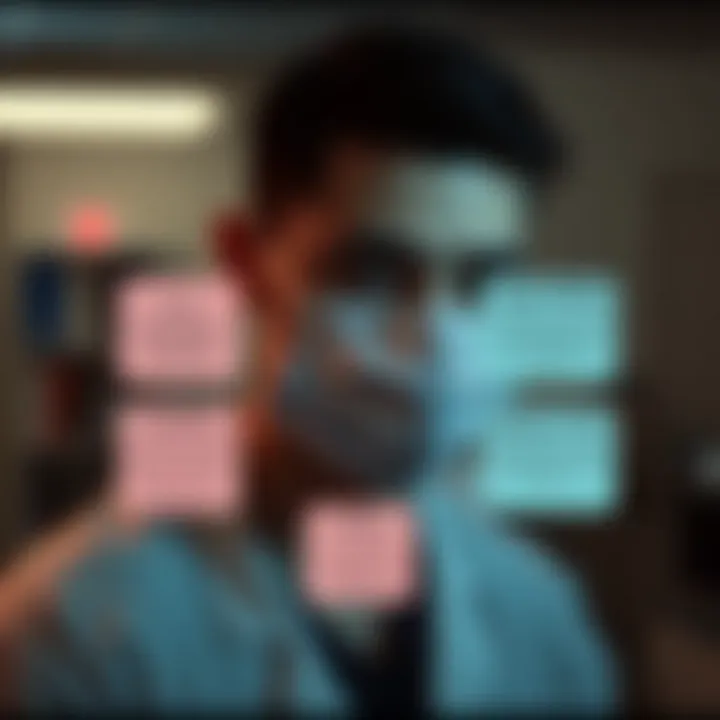Understanding MRSA Nasal Infections: Insights and Implications


Intro
Methicillin-resistant Staphylococcus aureus, or MRSA, has emerged as a formidable foe in the realm of infectious diseases. Its prominence as a nasal infection is often overlooked, yet it has significant implications for public health. Understanding the nuances of MRSA nasal infections allows healthcare professionals and the general public alike to grasp the severity of this condition. With antibiotic resistance becoming increasingly prevalent, comprehending the mechanisms behind MRSA—and how it differs from other pathogens—becomes an essential part of the conversation.
The clinical manifestations of MRSA nasal infections can range from mild irritation to more severe complications that necessitate medical intervention. In addition to symptoms, recognizing the risk factors, diagnostic methods, and prevention strategies tied to MRSA nasal infections is crucial. Assessing these elements lays the groundwork for effective response measures in both individual and community settings.
Throughout this article, we delve deep into all dimensions of MRSA nasal infections, shedding light on strategies for the diagnosis and management of this emerging public health concern. As we navigate through this intricate landscape, key insights will emerge that aim to enhance understanding for students, healthcare practitioners, and those seeking knowledge in this critical area.
Intro to MRSA
Methicillin-resistant Staphylococcus aureus, commonly known as MRSA, has become a topic of critical importance within the realm of infectious diseases. Understanding MRSA means confronting the realities of its pervasive nature and the challenges it poses in both clinical settings and the broader community. This introduction serves to lay the groundwork for a comprehensive exploration of MRSA nasal infections, elucidating their implications for public health, healthcare practices, and individual well-being.
As we delve into this complex subject, it is vital to grasp that MRSA is not just another strain of bacteria; it signifies a significant evolutionary adaptation that has emerged as a formidable opponent in the fight against infections. Bacterial resistance is akin to a rapidly evolving chess match where both the pathogen and the healthcare community continuously strategize against one another.
Definition of MRSA
MRSA is a type of staph bacteria that is resistant to certain antibiotics, particularly methicillin and related antibiotics such as penicillin. This resistance complicates treatment and has made MRSA a leading cause of hospital-acquired infections. Its ability to survive and thrive despite the presence of these drugs raises alarms in both hospital and community settings.
To define it simply, MRSA is a strain of Staphylococcus aureus that has developed mechanisms to evade the effects of common antibiotics, making ordinary treatments ineffective. Infections can range from mild skin issues to more severe conditions like pneumonia or bloodstream infections. Importantly, not all Staphylococcus aureus strains are resistant to antibiotics, but MRSA strains pose a unique challenge and a heightened risk.
History and Emergence of MRSA
The history of MRSA begins in the late 1950s, when methicillin was first introduced to treat infections caused by penicillin-resistant Staphylococcus aureus. Within a few years, MRSA was identified in various countries, signaling the start of an ongoing battle against antibiotic resistance. The emergence of MRSA coincides with increasing antibiotic use, often leading to the bacteria adapting to resist these drugs.
Initially, MRSA infections were primarily hospital-acquired; however, by the 1990s, the bacteria began spreading more widely in the community. This shift coincided with changes in lifestyle, demographics, and healthcare practices. Individuals with compromised immune systems, those undergoing surgery, or patients with long hospital stays became prime targets. Yet, healthy individuals participating in activities like sports or living in close quarters also became affected.
The rise of community-associated MRSA highlighted the significant risk it posed not just in hospitals, but in schools, gyms, and households. This transition underscores the need for a collective understanding of MRSA and proactive measures to prevent its spread. As we navigate through the complexities of MRSA nasal infections, it becomes clear that addressing these infections means addressing a broader public health challenge that impacts us all.
Pathophysiology of MRSA Nasal Infections
The pathophysiology of MRSA nasal infections serves as the bedrock for understanding how this formidable pathogen operates and affects human health. By delving into this area, we can uncover the underlying mechanisms that facilitate infections and the body’s response. Such insights are critical not only for diagnosis and treatment but also for proactive measures against future infections. The complexity of MRSA infections can be daunting, but grasping the dynamics of these processes can empower healthcare professionals and inform public health strategies.
Mechanisms of Resistance
Methicillin-resistant Staphylococcus aureus is notorious for its ability to resist conventional antibiotics, particularly methicillin and other beta-lactams. This resistance stems primarily from genetic mutations and the acquisition of resistance genes, making MRSA a survival expert in hostile environments such as the human body. The most significant mechanism of resistance involve the production of an altered penicillin-binding protein, commonly referred to as PBP2a. This change enables MRSA to evade the effects of methicillin and similar antibiotics.
In addition to the genes conferring antibiotic resistance, MRSA is capable of forming biofilms—complex communities of bacteria that adhere to surfaces and each other. These biofilms act as a shield against the immune response and antibiotics, allowing the bacteria to persist in nasal passages. This ability to form biofilms is influenced by environmental conditions and host factors, such as the presence of mucus, which can either promote or hinder biofilm development. Research indicates that biofilms can also be responsible for chronic infections, posing a significant challenge for eradication.
Some strains of MRSA have further evolved mechanisms to modify their metabolism and exploit host resources effectively, adding another layer of resilience. On top of that, they can express various virulence factors, including toxins, that undermine the immune response and facilitate invasion. Understanding these mechanisms is crucial for developing targeted treatment regimens and preventive measures.
Infection and Colonization Processes
The processes involved in infection and colonization by MRSA are intricately related. To start, colonization typically occurs in the nasal cavity, where a large proportion of the population unknowingly harbors MRSA. This initial colonization does not always result in disease; rather, it sets the stage for potential infections. In healthy individuals, the immune system can often keep MRSA in check, yet certain risk factors, whether immunocompromising conditions, skin breaches, or invasive medical procedures, can tip the balance towards infection.
Once the balance shifts, MRSA can lead to various complications, from mild skin abscesses to more severe systemic infections, depending on the individual's health status and underlying conditions. The transition from colonization to infection is often facilitated by environmental factors such as overcrowding, poor hygiene, and hospitalization.
Interestingly, MRSA’s ability to spread is not limited to direct contact. It can also spread through fomites, which are inanimate objects that carry the bacteria, such as towels, medical instruments, or even shared personal items. This route of transmission underscores the importance of infection control practices in community and healthcare settings.
"Understanding both the mechanisms of resistance and the processes of colonization can significantly aid in preventing and treating MRSA infections."
Lastly, successful infection relies on the bacteria's ability to efficiently adhere to host tissues and evade immune responses. This stage involves a complex interplay of microbial and host factors, including the production of protein adhesins that facilitate attachment to epithelial cells. Once established, these infections can become persistent, posing challenges for treatment interventions, thus highlighting the necessity for continual research and monitoring in tackling MRSA nasal infections effectively.
Clinical Presentation
The clinical presentation of MRSA nasal infections is pivotal in understanding the disease’s manifestation and implications. Identifying the nuances of this condition is essential for several reasons. First, the presentation serves as a glaring clue that aids healthcare professionals in diagnosing and selecting appropriate treatments. Unraveling the symptoms is fundamental to addressing not just the individual but the broader community health implications of MRSA. Given its ability to resist antibiotics, MRSA can spiral out of control if not properly managed, making the early recognition of symptoms all the more critical.
Symptoms of MRSA Nasal Infection
MRSA nasal infections can exhibit a varied range of symptoms, which may sometimes overlap with those of other nasal conditions. Some common symptoms include:
- Nasal congestion: This is often the first sign that something is amiss, as the nasal passages may become blocked.
- Mucopurulent nasal discharge: The discharge might be thick and cloudy, sometimes tinged with blood, individual to MRSA infections.
- Nasal pain or tenderness: Many patients report discomfort in the nasal area, which might feel swollen or inflamed.
- Fever: Accompanying systemic symptoms such as fever can signal a more serious infection.
- Skin lesions or boils: Sometimes, cutaneous manifestations occur in conjunction with nasal symptoms, indicating systemic involvement.
It's important to note that not everyone will experience all these symptoms. Some individuals may have minimal signs that could easily be dismissed, but this can lead to escalation of the conditions.
"The earlier the diagnosis, the better the chance of effective treatment; ignoring the symptoms can lead to serious complications."
Differential Diagnosis
Differential diagnosis for MRSA nasal infections can be tricky given the symptom overlap with various other conditions. Healthcare providers must interpret the symptoms with precision. Conditions that might present similarly include:
- Viral rhinitis (common cold): Symptoms like nasal congestion and discharge are common but tend to resolve with conservative treatment.
- Allergic rhinitis: Allergy symptoms include mucus production but generally do not present with fever or localized nasal pain.
- Sinusitis: Both acute and chronic sinusitis can present with nasal obstruction and pain, but may involve more severe facial pressure and dental pain.
- Other bacterial infections: Secondary bacterial infections can also masquerade as MRSA, such as those caused by Streptococcus pneumoniae or Haemophilus influenzae, which might complicate the clinical picture.
A comprehensive clinical assessment, including a detailed history and possibly lab testing, can help differentiate MRSA from these conditions. Given the potential for complications associated with untreated MRSA infections, astute clinical judgment is crucial in deducing the correct diagnosis.
Diagnosis of MRSA Nasal Infections


Diagnosing MRSA nasal infections is pivotal in both individual patient care and broader public health. Timely diagnosis helps in initiating appropriate treatment and management strategies, ultimately reducing the spread of this resistant strain of bacteria. Given the complexities surrounding MRSA and its clinical manifestations, adopting a multi-faceted approach in diagnosis is vital.
Laboratory Testing
Laboratory testing is the backbone of diagnosing MRSA infections. Among the various methods, nasal swabs are particularly significant due to their simplicity and effectiveness. A healthcare provider may collect a sample from the inside of a person's nose, which can be analyzed for the presence of MRSA. The results guide treatment and precautionary measures. However, not just any old swab will do; it has to be handled precisely to avoid contamination.
- Culture Tests: The most common laboratory test for MRSA detection is the culture test. In this method, the swab is placed on a medium that supports the growth of bacteria. If MRSA is present, it will multiply and can be identified.
- PCR Testing: Polymerase chain reaction (PCR) testing is a more rapid method that detects the genetic material of MRSA. This test can yield results within hours, which is a vast improvement over traditional cultures that may take days.
"The speed of PCR testing can be especially critical in hospital settings where the risk of outbreaks is high."
It is important to consider the accuracy of the tests. False positives and negatives can occur, which is why confirmatory tests are often recommended.
Another valuable laboratory tool is antibiotic susceptibility testing, which helps determine the best course of treatment by understanding which antibiotics the strain is resistant or susceptible to. This information is essential for tailoring an effective regimen for patients.
Clinical Assessment Methods
Complementing laboratory testing, clinical assessment methods play a vital role in diagnosing MRSA nasal infections. Healthcare providers utilize clinical history and physical examinations to assess symptoms and risk factors associated with MRSA.
In many cases, a patient may present symptoms such as:
- Persistent nasal drainage
- Redness or swelling in the nasal area
- Pain or discomfort in the nasal passages
Providers should inquire about recent hospitalizations, contact with others who have had MRSA infections, or previous antibiotic use, as these can elevate risk levels.
Physical exam findings may vary but can often include:
- Presence of abscesses or skin infections, suggesting an infection that could be linked to nasal colonization.
- Swelling in surrounding areas if the infection is severe.
Combining these clinical observations with the laboratory results yields a holistic view of the patient's situation. This multifaceted approach allows healthcare professionals to differentiate MRSA from other pathogens effectively, making it easier to manage and treat patients accordingly.
Treatment Options
The treatment of MRSA nasal infections is a crucial element that significantly affects patient outcomes. Given the prevalent antibiotic resistance associated with MRSA, understanding treatment options helps healthcare providers make informed decisions. The options available range from traditional antibiotic therapies to alternative modalities, each with its own implications and benefits. This section aims to elaborate on these key facets, ensuring that both practitioners and patients grasp the nuances involved in managing MRSA nasal infections.
Antibiotic Therapy
Antibiotic therapy remains at the forefront of treatment for MRSA nasal infections, albeit with its own unique challenges. Commonly employed antibiotics include clindamycin, trimethoprim-sulfamethoxazole, and doxycycline. However, the efficacy can vary based on the individual’s infection severity and strain resistance.
- Table of Common Antibiotics for MRSA:
- Clindamycin: Effective for skin and soft tissue infections.
- Doxycycline: Useful for its anti-inflammatory properties, as well.
- Trimethoprim-Sulfamethoxazole: A convenient oral option for outpatient treatment.
Though these medications are viable, monitoring for adverse reactions is vital. This includes awareness of gastrointestinal upset or potential allergic reactions. A healthcare professional must assess each case's risks and benefits with care.
"A stitch in time saves nine"—prompt intervention can minimize complications associated with MRSA infections, making timely antibiotic therapy essential.
Alternative Treatment Modalities
Aside from antibiotics, patients may explore alternative treatment modalities. These options can supplement traditional therapies or serve as standalone strategies, particularly when antibiotic resistance poses a challenge.
- Intranasal Antiseptics: Products like mupirocin or iodine-based solutions target nasal colonization effectively.
- Probiotics: Some studies suggest that restoring nasal flora might help combat MRSA infections. While the research is still emerging, integrating probiotics with standard therapy is gaining traction among healthcare providers.
- Natural Remedies: Essential oils, such as tea tree oil, may exhibit antibacterial properties, providing an adjunct to conventional treatments. However, clinical evidence remains sparse, and professional guidance is crucial to ensure safety and efficacy.
In summary, while antibiotic therapy is vital for MRSA nasal infections, alternative approaches offer additional avenues for management. Careful evaluation of these options by healthcare professionals will enhance treatment efficacy and patient safety, demonstrating a comprehensive approach to MRSA nasal infections.
Preventive Measures
Preventive measures for MRSA nasal infections are pivotal for reducing the incidence of this infection in both community and healthcare settings. Emphasizing prevention not only mitigates the disease burden but also helps curb the spread of antibiotic-resistant bacteria. Understanding how to implement effective preventive strategies is crucial for healthcare professionals, students, and researchers as they navigate this pressing public health issue.
Infection Control Practices
The cornerstone of preventing MRSA nasal infections lies in robust infection control practices. Hand hygiene stands at the forefront; thorough handwashing with soap and water or using hand sanitizers significantly reduces the transmission of MRSA. It might sound basic, but consistent practice can stop the bacteria from jumping from person to person in both hospitals and everyday settings. Educating individuals about the importance of hygiene etiquette when sneezing or coughing also plays a role in keeping the environment germ-free.
Moreover, healthcare facilities must adopt stringent cleaning protocols, especially in shared spaces. Regular disinfection of surfaces and medical equipment can minimize contamination risks. Consider the following key strategies for effective infection control:
- Screening for MRSA in high-risk populations, such as those in hospitals or long-term care facilities. Identifying carriers allows for targeted interventions.
- Isolation protocols to keep infected individuals separate from others, which is especially critical in clinical environments.
- Decolonization strategies, involving topical antiseptics or antibiotics for individuals who test positive, can vastly reduce their likelihood of spreading the bacteria.
Investing in training for healthcare staff about these practices is equally important. The more informed and vigilant the staff, the lower the chances of a MRSA outbreak.
Public Health Implications
When we talk about public health implications, the ripple effect of preventing MRSA infections cannot be overstated. Success in infection control practices does more than protect individuals; it strengthens community health as a whole. Fewer MRSA cases mean reduced healthcare costs, diminished hospital stays, and lower mortality rates, which is a win-win for everyone involved.
In terms of community awareness, effective public health campaigns can drastically change perceptions and behaviors around hygiene and infection prevention. Educational initiatives that inform the public about MRSA’s risks and preventive measures can increase vigilance and compliance. Here are a few implications to consider:
- Reduction in healthcare costs: Treating MRSA infections can be costly. By focusing on prevention, we can alleviate the burden on healthcare systems.
- Improved patient outcomes: With fewer people getting infected, the overall health standard rises, creating a safer environment for vulnerable populations like the elderly or those with compromised immune systems.
- Strengthened public trust: When communities see tangible results from prevention measures, public confidence in health systems increases.


Ultimately, embracing preventive measures against MRSA nasal infections isn't just about individual well-being—it's about protecting public health and ensuring a sustainable strategy towards managing antibiotic resistance in society. By fostering a culture of prevention, we can gradually diminish MRSA's grip on communities.
"An ounce of prevention is worth a pound of cure."
This age-old adage rings true in the context of MRSA; proactive measures today lead to healthier tomorrows.
Risk Factors for MRSA Nasal Infections
Understanding the risk factors associated with MRSA nasal infections is vital. Knowing the influences can help identify individuals who may face a higher threat. As MRSA can be a silent yet dangerous colonizer, awareness of these risk factors is key in facilitating timely interventions and preventive measures. By tailoring strategies based on these elements, healthcare professionals can work towards reducing the incidence of infections and managing outbreaks effectively.
Societal Influences
Several societal factors contribute to the rise of MRSA nasal infections. First off, overcrowding in urban areas or communal living environments, such as dormitories or nursing homes, increases the likelihood of transmission. Close physical proximity means that bacteria can spread easily among individuals.
Moreover, attitudes towards personal hygiene play a significant role. In communities where washing hands and maintaining cleanliness does not receive strong emphasis, the risk of colonization rises. Sometimes, people underestimate the importance of good hygiene, which can have serious consequences. Public awareness campaigns focused on proper hygiene practices can play a pivotal role in altering this narrative.
Additionally, socio-economic status cannot be ignored. Those in lower-income brackets may lack access to healthcare and educational resources about MRSA. The lack of awareness can mean that individuals do not recognize the symptoms early enough, resulting in complications down the line. Creating educational programs in high-risk communities is essential. By emphasizing personal responsibility, the cycle of infection can be disrupted.
In fact, as noted by the Centers for Disease Control and Prevention, communities with strong public health education initiatives experience lower rates of MRSA infections.
"Awareness is the first step to prevention. Without it, the fight against bacteria like MRSA becomes significantly harder."
Healthcare-Associated Risk
Healthcare settings present a distinct risk for MRSA nasal infections. Hospitals, for instance, are a breeding ground for various strains of bacteria due to the high concentration of patients with compromised immune systems. Surgical patients, those in intensive care units, and individuals with open wounds face heightened risks. When regular contact with healthcare providers occurs, so does a likelihood of exposure.
Instruments used in medical procedures, like catheters or ventilators, can also become a route for MRSA to enter the body. These devices often come into contact with mucous membranes, increasing the chance of infection. It's crucial for healthcare personnel to adhere strictly to infection control protocols to mitigate this threat.
Moreover, the role of antibiotic use in healthcare cannot be overlooked. Overprescribing antibiotics leads to increased resistance, as MRSA thrives in environments where other bacteria struggle. Antibiotic stewardship programs become imperative in guiding judicious use, hence minimizing the chance for MRSA to flourish.
To further reduce healthcare-associated MRSA infections, continuous training for medical staff on sterilization techniques and best practices is essential. Simplifying these protocols ensures they are easy to follow, creating a culture of safety within healthcare environments.
Comparative Analysis with Other Pathogens
Understanding the nuances of MRSA nasal infections requires an in-depth comparative analysis with other pathogens. This section is crucial as it not only sheds light on the unique aspects of methicillin-resistant Staphylococcus aureus but also helps to contextualize its prevalence and impact within the broader landscape of microbial infections. By evaluating the differences and similarities with other pathogens, healthcare professionals and researchers can develop more effective treatment plans and preventive strategies. Furthermore, these comparisons also contribute to our understanding of antibiotic resistance mechanisms, shedding light on how various bacteria survive in the presence of antibiotics.
Staphylococcus Aureus Characteristics
Staphylococcus aureus is a significant bacterial player in many infections, including MRSA nasal infections. The characteristics of this pathogen can be grouped into several key elements:
- Gram-Positive Structure: Being a gram-positive bacterium, Staphylococcus aureus has a thick peptidoglycan cell wall, which provides structural integrity and can resist certain antibacterial mechanisms.
- Coagulase Production: This bacterium is coagulase positive, which means it can produce an enzyme that coagulates blood plasma; this is a key feature that differentiates it from other Staphylococcus species and contributes to its virulence.
- Toxin Production: Staphylococcus aureus produces various toxins, including enterotoxins and toxic shock syndrome toxin-1, which can induce severe physiological responses in the host.
- Diverse Colonization: It can colonize various body sites, notably the anterior nares, making nasal MRSA infections particularly concerning. Colonization often leads to infections that can range from mild to serious, depending on the location and extent.
Overall, understanding the characteristics of Staphylococcus aureus is fundamental for addressing MRSA nasal infections effectively.
Comparison with Methicillin-Sensitive Strains
The comparison between MRSA and methicillin-sensitive Staphylococcus aureus (MSSA) is pivotal, especially when addressing treatment and management strategies. Key differences include:
- Antibiotic Resistance: The most prominent difference is the resistance to methicillin and other beta-lactam antibiotics found in MRSA strains. This resistance arises from the acquisition of the mecA gene, which encodes a penicillin-binding protein that does not effectively bind beta-lactams.
- Infection Severity: Infections caused by MRSA can be more severe and harder to treat than those caused by MSSA. While MSSA infections are often manageable with common antibiotics, MRSA infections frequently require alternative, more potent therapies.
- Prevalence and Risk Factors: MRSA tends to be more prevalent in certain populations, especially those in healthcare settings, while MSSA is more commonly found in healthy individuals and is often associated with skin infections.
Due to these differences, addressing MRSA infections necessitates a tailored approach that takes into account the specific challenges posed by the resistance mechanisms and the pathogenic potential of MRSA.
In summary, a comparative analysis between MRSA and other pathogens, specifically MSSA, enhances our comprehension of MRSA's alarming rise and its implications for public health. To understand how to manage MRSA effectively, it is crucial to consider these distinctions.
Epidemiology of MRSA Nasal Infections
Understanding the epidemiology of MRSA nasal infections is crucial for grasping the scope and impact of this public health issue. MRSA, or methicillin-resistant Staphylococcus aureus, isn't an isolated phenomenon; rather, it reflects broader trends in infectious diseases that can strain both healthcare systems and communities. By exploring the patterns of prevalence and distribution, we gain insights that can drive effective prevention and management strategies.
Global Prevalence Trends
The prevalence of MRSA nasal infections has shown varying trends across the globe. Studies reveal that in some regions, like North America and parts of Europe, the rates have stabilized or even declined in hospital settings due to rigorous infection control measures. In contrast, in many developing countries, the burden remains high. For instance, certain areas in Africa and Asia continue to experience alarming rates of community-associated MRSA infections, leading to spikes in morbidity and mortality.
- Key Factors Influencing Trends:
- Implementation of strict guidelines for antibiotic usage in hospitals.
- Increased awareness and training of healthcare personnel.
- Local socio-economic conditions affecting healthcare access.
"Shifts in MRSA epidemiology underscore the need for continuous surveillance and targeted interventions."
Without tailoring responses to these trends, health initiatives risk missing the mark, highlighting the need for data-driven decisions in tackling MRSA.
Geographical Distribution
The geographical distribution of MRSA nasal infections reveals stark contrasts that can inform both public health policies and clinical practices. Certain urban centers face higher incidences compared to rural areas. For instance, cities with high population density often contribute to faster transmission rates—due in part to close living quarters and increased human interactions.
- Urban vs. Rural Dynamics:
- Urban centers often display higher prevalence due to factors like overcrowding, homelessness, and transient populations.
- Rural areas may see sporadic outbreaks, often linked to specific risk factors such as farming or livestock exposure.


In addition to urban-rural discrepancies, international travel has become a notable factor in MRSA spread. Travelers can inadvertently introduce strains of MRSA from areas with higher prevalence, making global health diplomacy paramount in monitoring and managing outbreaks.
- Notable Regions:
- Southern Europe has reported some of the highest MRSA rates in hospitals, necessitating focused interventions.
- Asia, especially Southeast Asia, has shown varying patterns, with some countries implementing successful containment measures while others struggle with rising numbers.
Recognizing these geographical nuances not only aids in preventive efforts but also fosters a unified front against a common foe—MRSA nasal infections.
Impact on Public Health
The emergence of MRSA (Methicillin-resistant Staphylococcus aureus) as a significant health threat necessitates a comprehensive understanding of its impact on public health. MRSA nasal infections are becoming increasingly common, and their implications extend beyond individual health, deeply influencing healthcare systems globally. This section will detail the healthcare burden and economic repercussions associated with MRSA, shedding light on the multifaceted challenges it poses.
Healthcare Burden
The burden of MRSA on healthcare facilities is substantial. To put it plainly, when MRSA is involved, it complicates cases that might otherwise be straightforward. Hospitals and clinics must adapt their protocols to manage these infections properly, which often entails additional layers of care. For instance, patients carrying MRSA often require longer hospital stays and isolation precautions to prevent transmission to other individuals, which unnaturally inflates the strain on healthcare resources.
Some notable points about the healthcare burden include:
- Increased Hospitalization Rates: Patients with MRSA infections frequently face longer admissions due to complications such as abscess formation or systemic infection. This leads to reduced bed availability for other patients, exacerbating overcrowding issues.
- Antibiotic Stewardship Challenges: The rise of MRSA has led to a need for more stringent antibiotic use policies. There is a delicate balance between treating infections effectively while also combating further resistance development, making clinical decision-making complex.
- Staffing Implications: The presence of MRSA strains necessitates additional training for healthcare providers, contributing to workforce strain. This demand can divert staff from other essential healthcare services.
By recognizing these factors, we gain insight into the significant challenges hospitals face amid rising MRSA rates. Reduced patient turnover and resource allocation create not just logistical complications but potentially impact overall patient outcomes.
Economic Implications
Beyond the direct healthcare impact, MRSA infections generate serious economic repercussions that must not be overlooked. The costs associated with MRSA extend well into the billions yearly. Understanding these implications offers a clearer view of the financial burden placed on both healthcare systems and patients alike.
Key economic points include:
- Cost of Treatment: The financial burden of treating MRSA infections is considerable. Common treatments involve expensive antibiotics and extended hospital care, which may not always be covered comprehensively by insurance plans.
- Increased Out-of-Pocket Expenses: Patients face higher direct costs when treated for MRSA, not including loss of income due to missed work. This financial strain can discourage individuals from seeking necessary medical attention, perpetuating a cycle of untreated infections.
- Impact on Workforce Productivity: Apart from direct healthcare costs, MRSA infections can lead to decreased productivity in the workforce. Illnesses can result in employee absenteeism, further straining economic systems, particularly in industries heavily reliant on their workforce.
The repercussions of MRSA extend beyond the patient’s bedside, affecting families, communities, and economies.
Acknowledging these multifaceted impacts on public health allows for better-informed discussions about MRSA management strategies. Enhanced awareness can ultimately lead to more effective interventions and greater support for funding necessary research into prevention and treatment methodologies.
Controversies in MRSA Management
The management of MRSA nasal infections continues to spark heated discussions among medical professionals, researchers, and public health advocates. A myriad of factors contribute to this contentious landscape, where the stakes are high not only for patient outcomes but also for broader public health initiatives. Understanding these controversies is pivotal to developing effective strategies and refining existing protocols. The debates range from screening policies to ethical dilemmas surrounding treatment options, all of which inform how communities respond to the MRSA threat.
Debates on Screening Policies
One of the main flashpoints in the MRSA management discussion is the efficacy and necessity of screening policies. On one hand, comprehensive screening in high-risk populations—such as hospital patients or athletes in close-contact sports—can identify carriers and prevent outbreaks. Policies advocating for universal screening tend to emphasize the importance of early detection as a means to curtail the spread of MRSA. In practice, widespread screening may lead to more informed treatment pathways and potentially reduce infection rates.
On the flip side, critics raise concerns about the cost-effectiveness and practicality of such policies. There is the argument that universal screening may not yield significant benefits relative to the resources required. Additionally, screening can lead to undue alarm for patients who test positive but remain asymptomatic. This raises the question: is the potential reduction in infection rates worth the emotional and psychological burden placed on individuals who may be labeled as carriers?
Moreover, guidelines can vary significantly between different institutions and regions, leading to inconsistent application of screening protocols. This inconsistency not only complicates public health messaging but can also hinder the ability to accurately assess MRSA prevalence in communities. Thus, striking the right balance between proactive screening and resource allocation remains a pressing concern in MRSA management.
Ethical Considerations in Treatment
When it comes to treatment, ethical considerations complicate decision-making for healthcare providers. The decision to treat a patient for an MRSA nasal infection involves not just questions of clinical efficacy but also broader ethical implications. For instance, should healthcare providers prioritize antibiotics that target MRSA even in cases where the infection might resolve without intervention?
This issue brings to light concerns about antibiotic overuse and resistance. Prescribing antibiotics too readily can exacerbate resistance patterns, leading to a cycle that undermines the effectiveness of existing treatments. Ethical dilemmas thus often arise when weighing the immediate benefits of antibiotic therapy against the long-term implications of fostering resistance.
Another layer of complexity involves informed consent. Patients must be made aware of their diagnosis and treatment options, including the potential repercussions of antibiotic use. For healthcare visitors, the challenge is not merely to prescribe treatment but to engage in conversations that equip patients with the understanding to make informed choices.
"It is crucial for physicians to consider not just the science, but also the ethics of their treatment decisions."
Future Directions in Research
Research surrounding MRSA nasal infections isn’t merely academic; it holds the promise of shifting paradigms in how we approach treatment and prevention. As the global burden of these infections continues to rise, innovative research avenues can offer significant benefits to healthcare practices and public health strategies.
Emerging Therapeutics
The hunt for new treatments is like trying to hit a moving target. Traditional antibiotics that might have once been effective are losing steam against MRSA. Hence, researchers are exploring novel therapeutics that may not only combat resistant strains but also minimize side effects associated with current treatments.
One promising direction is the development of bacteriophages—viruses that specifically target bacteria. Through precision engineering, these viruses could outsmart MRSA, providing a route for treatment that bypasses traditional antibiotic resistance mechanisms.
Another exciting avenue involves the use of peptides derived from host-defense proteins. These bioactive compounds can physically disrupt bacterial membranes, leading to their death without the typical collateral damage observed with broad-spectrum antibiotics. A recent study indicated that designing synthetic versions of these peptides could yield a potent therapeutic option in the face of increasing resistance.
Additionally, the potential of CRISPR gene-editing technology has sparked interest. Imagine being able to alter the genetic makeup of bacteria to render them harmless. While this is still largely theoretical, researchers are beginning to experiment with CRISPR to selectively attack MRSA while preserving beneficial microbial communities.
Innovations in Prevention Strategies
As they say, an ounce of prevention is worth a pound of cure. This age-old wisdom is profoundly applicable to MRSA nasal infections. Enhancing prevention strategies represents a critical frontier in the fight against these pathogens.
One novel approach emphasizes the importance of nasal microbiome modulation. The idea is to maintain a healthy balance of bacteria within the nasal cavity, using probiotics to outcompete MRSA colonizers. Research has shown that certain strains of Lactobacillus can help restore a beneficial bacterial environment, thereby reducing the likelihood of MRSA infections.
Moreover, the incorporation of advanced technologies in prevention cannot be overlooked. Wearable health technology has the potential to monitor individuals in healthcare settings. This real-time data can identify carriers, allowing for targeted interventions before infection spreads further within a community.
"Public health strategies must evolve to encapsulate these advanced methods and technologies to outpace the adaptive nature of MRSA."
Finally, ongoing training and education about MRSA among healthcare professionals and community members are paramount. Knowledge is power—understanding infection control measures can significantly reduce transmission rates, thus lowering infections overall.
As the landscape of healthcare transforms, these future directions in research are not just vital; they are necessary. Understanding the threats posed by MRSA and fostering a proactive research spirit can help mitigate what is shaping up to be a persistent public health crisis.







